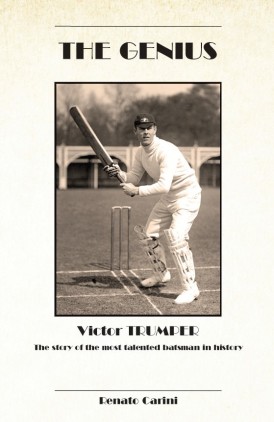The Genius
Martin Chandler |Published: 2019
Pages: 395
Author: Carini, Renato
Publisher: Carini, Renato
Rating: 3.5 stars

One of the best known cliches is the one that asserts there are three kinds of untruths; lies, damned lies and statistics. The line is generally attributed to the nineteenth century British Prime Minister, Benjamin Disraeli. Test cricket began whilst Disraeli was in power, but I am not aware that he had any time for the game, and even if he had in an era when there was rather less attention paid to averages than there is now he would have had no reason to believe his famous figure of speech would ever have a place in cricket.
I recently read and reviewed Peter Kettle’s Rescuing Don Bradman From Splendid Isolation, a study which explored the Don’s figures to see whether, interpreted differently, they pointed to a cricketer who was not quite as far out on his own as he at first blush seems to have been. The Genius, as its title suggests, is more of the same on a different subject, and with the opposite mission statement.
The Genius in question is Victor Trumper, judged by averages the 71st best batsman Australia has produced. It is first time author Renato Carini’s contention that Trumper’s statistics do him a grave disservice, and over the course of 395 pages he sets out to explain why, and marshall the evidence in support of his case.
It is sad that we do not have a library of archive film of Trumper in action, in some ways the more so because of what we can see, most particularly that wonderful Beldam photograph of the man jumping out to drive, about which no less a writer than Gideon Haigh published a whole book a couple of years ago. Carini has a point of course. The batsman who plays every shot in the book and is always looking to score must surely be more deserving of superlatives than the man who has only two or three scoring areas but, to supplement them, has limitless patience, stamina and concentration.
When I first heard that The Genius was to be published my main concern was that it would be another interesting but ultimately disappointing biography of Trumper. That is a task that has already been attempted by Jack Fingleton, Peter Sharpham and Ashley Mallett. All three were frustrated by gaps in the story, and Haigh wisely chose not to follow the same path and to simply concentrate on that iconic image. In fact however I need not have worried. Carini’s concern is to put Trumper’s genius in its proper perspective, and the book is not an attempt at a biography.
What Carini does is take an exceptionally thorough look at every innings that Trumper played, at Test, First Class and Grade level. There is detailed analysis, plenty of diagrams and a complete statistical record of the career of a man whose artistry and style have been the subject of more hero worship than any other batsman in the history of the game. The conclusion, of course, fully justifies the book’s title, and puts all the lavish praise in context.
In case my comments might suggest otherwise I should also make the point that the book is illustrated throughout. There is nothing Beldamesque unfortunately, and quite a few of the photographs are fairly grainy and not of the best quality. Many however are reproduced here for the first time, and there is much of interest in them. Those in the sixth appendix in themselves, despite their low quality, do much to help modern readers understand what all the fuss was about. The juxtaposition of images of Ranji, Alan Marshal and Stanley Jackson jumping out to drive, renowned stylists all, with Beldam’s of Trumper does the same.
Carini also, indirectly, does cricket literature a great service. One of the first cricket books I read was Arthur Mailey’s splendid autobigraphy, 10-66 And All That. The best chapter in the book bears the title Opposing My Hero, and tells the story of when the young Mailey bowled to Trumper in a Grade match. He took Trumper’s wicket and described his feelings as being akin to a boy who had killed a dove. Over the years an inability to find any record of the match concerned slightly tarnished Mailey’s reputation for veracity, but the dismissal, which took place on 1 April 1911 is confirmed here*.
For non-statisticians The Genius can drag a little, as it will for those who need no convincing that Trumper fully merits the description. It is certainly an interesting study however, and the reader is left with no choice but to admire Carini greatly for his devotion to his task. Not all cricket lovers are slaves to statistics of course, but even those very few who seem generally unimpressed by them should still have a look at the book, as that sixth appendix is almost worth the outlay on its own.
*I understand that the scorecard in question was first located by historian/writer Alfred James in 2008, Mailey not having assisted by asserting that Trumper had been playing for Paddington that day rather than, as was in fact the case, Gordon.






Leave a comment